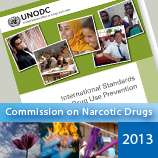 13 March 2013 - In the past, drug prevention work was often limited to printing leaflets to warn young people about the dangers of illicit drugs. Such interventions often resulted in little behavioural change. Now, through scientific advances, drug prevention has come a long way. Science-based prevention strategies working with families, schools and communities can ensure that children and youth, especially the most marginalized and poor, grow and stay healthy and safe into adulthood and old age. For every dollar spent on prevention, at least ten can be saved in future health, social and crime costs.
13 March 2013 - In the past, drug prevention work was often limited to printing leaflets to warn young people about the dangers of illicit drugs. Such interventions often resulted in little behavioural change. Now, through scientific advances, drug prevention has come a long way. Science-based prevention strategies working with families, schools and communities can ensure that children and youth, especially the most marginalized and poor, grow and stay healthy and safe into adulthood and old age. For every dollar spent on prevention, at least ten can be saved in future health, social and crime costs.
The factors that place people at risk of using drugs are diverse throughout the world, as are the structures and resources available to prevent drug use. The International Standards are intended to guide policymakers worldwide to develop programmes, policies and systems that are a truly effective investment in the future of children, young people, families and communities.
The global International Standards summarize the currently available scientific evidence and identify the major components and features of an effective national drug prevention system. The document describes interventions that have been proven to be effective in various countries, broken down by age category. It also outlines some drug prevention issues that require further research.
They build on and recognize the work of many other organizations, including the European Monitoring Centre for Drugs and Drug Abuse, the Inter-American Drug Abuse Control Commission, the World Health Organization, Mentor Foundation, the Canadian Centre on Substance Abuse and the National Institute on Drug Abuse, which have previously developed standards and guidelines on various aspects of drug prevention. Moreover, an extensive international group of experts participated in the development of the document.
International Standards on Drug Use Prevention and appendices